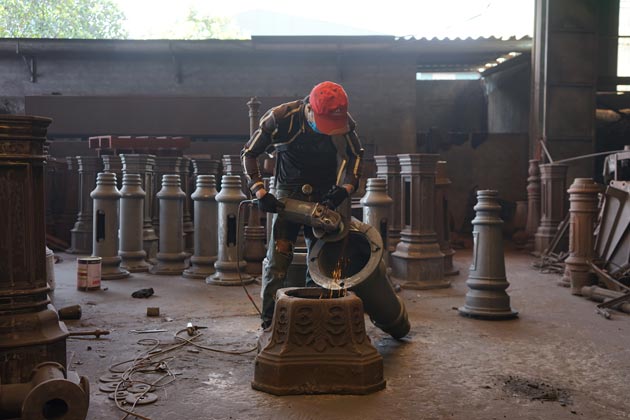Just How Aluminum Foundry Adds To Advancements in Aerospace Design
Aluminum factories are indispensable to improvements in aerospace engineering. They generate light-weight, high-strength components that are crucial for modern aircraft. Through advanced spreading strategies, these factories develop complicated geometries that enhance architectural honesty. Furthermore, the advancement of superior Aluminum alloys sustains the sector's concentrate on fuel effectiveness and sustainability. Challenges continue to be in the production process. Understanding these variables discloses the profound influence of Aluminum on air travel's future.
The Value of Lightweight Materials in Aerospace Layout
As the aerospace market remains to develop, the relevance of lightweight products comes to be progressively noticeable. The need for performance and sustainability drives designers to prioritize making use of products that minimize general weight without jeopardizing structural stability. Light-weight products, especially Aluminum, play a necessary duty in enhancing fuel effectiveness, boosting haul capability, and enhancing the total efficiency of airplane.
The combination of these products permits for ingenious designs, enabling manufacturers to develop more aerodynamic forms that can hold up against severe problems. The decrease in weight not only decreases operational prices however also contributes to a decreased environmental footprint, aligning with global initiatives toward sustainability in air travel.
Advanced Spreading Techniques in Aluminum Foundries
Advanced casting techniques in Aluminum foundries play an important role in aerospace design by allowing the production of lightweight and exact parts. Innovations in mold layout and precision casting procedures are vital in achieving suitable performance and architectural honesty. Furthermore, the advancement of lightweight alloys enhances the total performance and efficiency of aerospace applications.
Ingenious Mold And Mildew Style
Innovative mold and mildew design plays an essential duty in the effectiveness and performance of Aluminum shops, particularly within the aerospace market. By leveraging innovative products and methods, modern mold and mildews can be crafted to stand up to high temperatures and pressures, making certain peak performance throughout the spreading process. These designs typically incorporate complex geometries that allow for the manufacturing of lightweight yet structurally sound elements, crucial for aerospace applications. Additionally, the use of computer-aided style (CAD) software program promotes accurate modeling, making it possible for foundries to fine-tune and imitate mold and mildew layouts before physical production begins. This not just improves the quality of actors parts but likewise minimizes waste and lead times, resulting in significant expense savings. Generally, innovative mold and mildew layout is a foundation of progression in Aluminum Foundry modern technology for aerospace engineering.
Precision Casting Procedures
The efficiency of innovative mold designs seamlessly integrates with precision casting processes, which are vital for generating premium Aluminum components in aerospace design. These procedures, including sand casting, pass away spreading, and financial investment casting, ensure the production of complex geometries with limited tolerances. Advanced strategies like vacuum casting and stress die casting enhance the honesty and surface coating of the end products. Precision spreading decreases material waste while optimizing the mechanical properties of Aluminum, crucial for aerospace applications. Additionally, employing real-time tracking and progressed simulation devices during the spreading procedure permits immediate adjustments, leading to enhanced top quality control. Jointly, these precision casting processes placement Aluminum shops at the leading edge of aerospace development, sustaining the industry's need for integrity and efficiency.
Lightweight Alloy Development
As aerospace engineers seek to enhance fuel efficiency and performance, lightweight alloy advancement ends up being a necessary focus in Aluminum factories. These factories use advanced casting techniques to produce alloys that provide exceptional strength-to-weight ratios. Technologies in alloy structure, consisting of the incorporation of components like lithium and magnesium, make it possible for the production of materials that stand up to severe conditions while decreasing total airplane weight. Strategies such as die spreading and investment casting promote the precision manufacturing of complex forms, which are crucial for aerospace applications. Furthermore, continuous study intends to enhance these alloys for improved mechanical residential properties and increased toughness. By focusing on lightweight alloy advancement, Aluminum foundries substantially contribute to the evolution of aerospace engineering, paving the way for much more lasting and effective aircraft layouts.

Enhancing Architectural Stability With Aluminum Elements
Aluminum components supply significant advantages in enhancing architectural stability within aerospace design. Their lightweight nature adds to general performance while preserving stamina, which is necessary for airplane performance. Additionally, the stress and anxiety resistance properties of Aluminum aid guarantee the longevity and integrity of aerospace structures under different operational problems.
Lightweight Material Advantages
While typical products commonly endanger weight for strength, using Aluminum elements in aerospace design offers substantial benefits in architectural stability. Aluminum's light-weight nature adds to overall design effectiveness, enabling more structured airplane that take in much less fuel, therefore improving sustainability. The product's exceptional strength-to-weight ratio guarantees that components keep longevity without adding unnecessary mass. This quality fosters improved performance and agility in flight, along with optimized haul capabilities. In addition, Aluminum's resistance to rust extends the lifespan of aerospace frameworks, lowering upkeep prices and enhancing security. As makers progressively embrace Aluminum alloys, the aerospace sector experiences a transformative shift towards more reliable and effective design solutions that focus on both efficiency and environmental duty.
Tension Resistance Features
Although various materials have one-of-a-kind residential or commercial properties, Aluminum's outstanding stress resistance stands apart as an important consider boosting the structural stability of aerospace parts. This resistance plays a vital function in guaranteeing that aircraft can stand up to numerous functional stresses, consisting of tiredness, impact, and ecological problems. Aluminum alloys, particularly crafted for aerospace applications, exhibit high tensile stamina while preserving lightweight qualities, making it possible for designers to develop more efficient frameworks - Aluminum Foundry. Additionally, the ability of Aluminum to sustain cyclic loading without substantial deformation contributes to the durability and integrity of aerospace elements. As innovations proceed in Aluminum Foundry techniques, the advancement of stress-resistant Aluminum components promises more enhancements in efficiency, security, and performance throughout the aerospace industry, strengthening Aluminum's role as a preferred product in modern engineering
Gas Effectiveness Improvements Driven by Aluminum Innovations
As the aerospace industry seeks to boost fuel efficiency, ingenious uses Aluminum have arised as an essential solution. Aluminum's lightweight nature especially reduces airplane weight, permitting reduced fuel usage throughout flight. This decrease in weight is essential, as even tiny declines can result in substantial renovations in overall fuel economy.
Advanced Aluminum alloys, created for improved stamina and toughness, make it possible for manufacturers to produce parts that maintain architectural integrity while reducing mass - Aluminum Foundry. Additionally, the integration of Aluminum in airframes and engine parts assists in enhanced the rules of aerodynamics, adding to minimized drag and raised efficiency
The fostering of Aluminum in aerospace not just fulfills the need try these out for fuel-efficient layout but also aligns with regulatory pressures for lower exhausts. As these technologies continue to evolve, they play a significant role in establishing new benchmarks for gas efficiency, making certain that the aerospace industry can satisfy expanding economic and environmental challenges.

The Duty of Aluminum in Sustainable Air Travel Practices
The increasing focus on lasting air travel practices has actually positioned Aluminum as an important material in the quest for greener airplane layout. Known for its light-weight properties, Aluminum significantly reduces airplane weight, bring about lower gas consumption and discharges. Its recyclability better improves its sustainability account, as Aluminum can be reused forever without loss of high quality. This particular sustains a round economic situation within the aeronautics field, lessening waste and resource depletion.
Innovations in Aluminum alloys have actually boosted their strength and rust resistance, enabling for longer service life and decreased maintenance demands. These technologies help with the development of a lot more efficient aircraft structures, adding to overall sustainability initiatives. Additionally, Aluminum's thermal conductivity plays an important function in energy-efficient styles, improving systems such as heat exchangers. Jointly, these features emphasize Aluminum's essential role beforehand lasting aviation, straightening with worldwide efforts focused on lowering the environmental effect of flight.
Difficulties Encountered by Aluminum Foundries in Aerospace Manufacturing
While Aluminum factories play a crucial function in aerospace manufacturing, they face considerable challenges that can influence production efficiency and high quality. One major obstacle is the rigorous quality assurance requirements required in the aerospace sector. Any problem can compromise security and efficiency, necessitating rigorous inspection processes that expand production timelines. In addition, shops usually contend with changing resources expenses, which can affect pricing and success. The intricacy of Aluminum alloys used in aerospace applications additional makes complex the production process, as precise formulas are vital for achieving desired mechanical buildings. Knowledgeable labor shortages hinder the capacity to keep top quality manufacturing levels. Ecological policies enforce constraints on discharges and waste monitoring, requiring shops to invest in lasting techniques, which can be cost-prohibitive. These variables jointly produce a landscape where Aluminum foundries must continuously adjust to meet the progressing needs of aerospace production while ensuring safety and conformity.
Future Fads in Aluminum Applications for Aerospace Design
With innovations in modern technology and raising demands for efficiency, the future of Aluminum applications in aerospace engineering is positioned for substantial makeover. The combination of ingenious Aluminum alloys and compounds is expected to enhance strength-to-weight ratios, reference causing more fuel-efficient aircraft designs. Furthermore, innovations in additive production methods will certainly permit the production of intricate Aluminum frameworks that were formerly impossible, maximizing efficiency and decreasing waste.

Sustainable methods will certainly play a vital duty, with an expanding emphasis on reusing Aluminum to lessen ecological impact. The aerospace sector is likely to accept smarter making processes, such as automation and expert system, guaranteeing better and precision in Aluminum components. Partnerships in between Aluminum shops and aerospace companies will certainly foster research study and development, paving the means for brand-new applications that satisfy the rigid needs of modern aerospace engineering. Overall, the future looks assuring for Aluminum's function fit the skies
Frequently Asked Inquiries
What Are the Environmental Effects of Aluminum Production in Aerospace?
The ecological impacts of Aluminum production in aerospace include significant power intake, greenhouse gas discharges, and environment disturbance. Additionally, mining processes can result in soil deterioration and water contamination, elevating issues about sustainability and eco-friendly balance.
How Does Aluminum Compare to Various Other Products in Aerospace Applications?
Aluminum offers a distinct mix of lightweight residential properties, corrosion resistance, and cost-effectiveness contrasted to other products. Its high strength-to-weight ratio makes it particularly helpful for aerospace applications, boosting gas performance and overall performance in airplane design.
What Credentials Do Aluminum Foundry Employees Requirement for Aerospace Projects?
Aluminum Foundry workers call for customized training in metallurgy and spreading methods, together with knowledge of aerospace sector requirements. Accreditations in quality control and safety and security procedures are also important to guarantee conformity with rigid aerospace job demands.
Exist Any Kind Of Safety Interest In Making Use Of Aluminum in Aerospace Design?
Safety and security concerns pertaining to Aluminum in aerospace engineering consist of vulnerability to stress, tiredness, and rust fractures. Appropriate therapy and alloy selection are important to alleviate these risks, making sure architectural honesty and overall safety and security in aerospace applications.
Exactly How Does Aluminum Recycling Benefit the Aerospace Sector?
Aluminum reusing significantly profits the aerospace market by reducing product prices, lessening ecological effect, and conserving power. This lasting practice improves the market's performance while promoting using light-weight, high-performance components in aircraft manufacturing.
Advanced casting methods in Aluminum foundries play an important function in aerospace engineering by making it possible for the manufacturing of accurate and lightweight components. Ingenious mold and mildew style plays a crucial duty in the efficiency and efficiency of Aluminum foundries, specifically within the aerospace industry. As aerospace engineers look for to boost fuel performance and performance, light-weight alloy development becomes an essential focus in Aluminum foundries. Aluminum alloys, especially engineered for aerospace applications, exhibit high tensile strength while keeping lightweight characteristics, allowing designers to make extra efficient frameworks. Partnerships between Aluminum factories and aerospace firms will certainly cultivate study and development, paving the way for new applications that click for source fulfill the stringent needs of modern aerospace design.